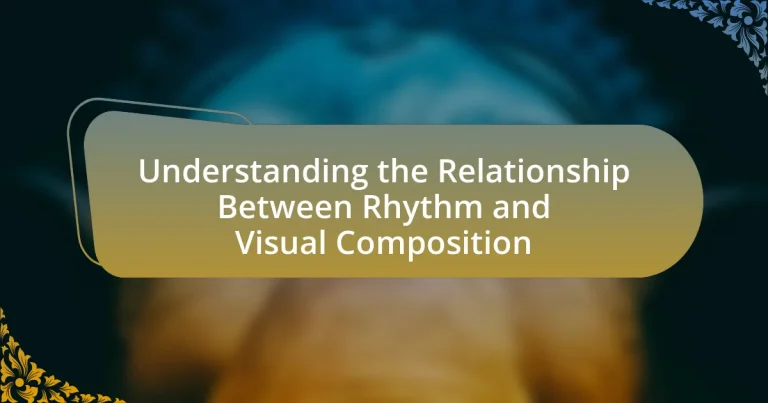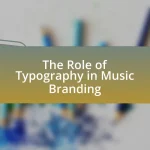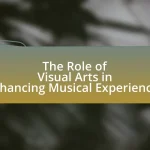The article explores the relationship between rhythm and visual composition, emphasizing how rhythm, defined by the arrangement and repetition of visual elements, creates movement and flow in art and design. It discusses the interaction of rhythm with visual composition, highlighting key elements such as repetition, variation, and movement, and their impact on viewer perception and emotional engagement. The article categorizes different types of rhythm, including regular, alternating, and progressive rhythms, and examines their application across various mediums, including traditional art forms and digital media. Additionally, it provides practical tips for artists and designers on incorporating rhythm into their work while identifying common mistakes to avoid.

What is the Relationship Between Rhythm and Visual Composition?
Rhythm in visual composition refers to the arrangement of elements in a way that creates a sense of movement and flow, similar to rhythm in music. This relationship is established through repetition, contrast, and variation of visual elements such as shapes, colors, and lines, which guide the viewer’s eye and create a cohesive experience. For instance, in graphic design, the consistent use of shapes can create a rhythmic pattern that enhances the overall aesthetic and engages the audience. Studies in visual perception indicate that rhythmic patterns can significantly influence how viewers interpret and interact with visual content, demonstrating the importance of rhythm in effective visual communication.
How do rhythm and visual composition interact in art and design?
Rhythm and visual composition interact in art and design by creating a dynamic flow that guides the viewer’s eye and enhances the overall experience. Rhythm, defined as the repetition of elements, establishes a sense of movement and pattern within a composition. This movement can be achieved through the strategic placement of shapes, colors, and lines, which collectively contribute to the visual hierarchy. For instance, in the works of artists like Piet Mondrian, the use of geometric shapes and primary colors creates a rhythmic balance that draws attention and maintains engagement. Studies in visual perception indicate that rhythmic patterns can evoke emotional responses, thereby reinforcing the intended message of the artwork. Thus, the interplay between rhythm and visual composition is essential for effective communication in art and design.
What are the key elements of rhythm in visual composition?
The key elements of rhythm in visual composition are repetition, variation, and movement. Repetition creates a sense of consistency and unity, allowing viewers to recognize patterns within the artwork. Variation introduces differences in elements such as color, shape, or size, which can enhance interest and prevent monotony. Movement guides the viewer’s eye through the composition, establishing a dynamic flow that can evoke emotional responses. These elements work together to create a cohesive visual experience, as seen in the works of artists like Piet Mondrian, whose use of geometric shapes and primary colors exemplifies rhythmic balance and harmony.
How does rhythm influence the viewer’s perception of visual art?
Rhythm significantly influences the viewer’s perception of visual art by creating a sense of movement and flow within the composition. This rhythmic quality can guide the viewer’s eye across the artwork, establishing a visual narrative that enhances emotional engagement. For instance, artworks that utilize repeating patterns or alternating colors can evoke feelings of harmony or tension, depending on their arrangement. Research indicates that rhythm in visual art parallels musical rhythm, where both can elicit similar emotional responses, as demonstrated in studies by researchers like Margaret Livingstone, who explored the connection between visual perception and rhythm in her work “Vision and Art: The Biology of Seeing.” This evidence supports the idea that rhythm not only shapes the aesthetic experience but also affects the cognitive processing of the artwork, leading to a deeper understanding and appreciation.
Why is understanding this relationship important for artists and designers?
Understanding the relationship between rhythm and visual composition is crucial for artists and designers because it enhances the effectiveness of their work in conveying emotions and messages. Rhythm in visual art refers to the repetition and arrangement of elements, which can guide the viewer’s eye and create a sense of movement. For instance, studies in visual perception indicate that artworks with a strong rhythmic structure can evoke specific emotional responses, making the piece more engaging. This understanding allows artists and designers to strategically use rhythm to influence how their audience interacts with their work, ultimately leading to more impactful and memorable designs.
How can rhythm enhance the emotional impact of visual compositions?
Rhythm enhances the emotional impact of visual compositions by creating a sense of movement and flow that guides the viewer’s experience. This structured arrangement of visual elements, such as lines, shapes, and colors, establishes a pattern that can evoke specific feelings, such as excitement or calmness. For instance, a rhythmic repetition of vibrant colors can generate energy and dynamism, while a more subdued, rhythmic arrangement of softer hues can instill tranquility. Research in visual perception indicates that rhythm can influence emotional responses by activating neural pathways associated with emotional processing, thereby reinforcing the intended message of the composition.
What role does rhythm play in guiding the viewer’s eye through a composition?
Rhythm plays a crucial role in guiding the viewer’s eye through a composition by creating a visual flow that directs attention and enhances engagement. This flow is established through the repetition of elements, such as shapes, colors, or lines, which establishes a pattern that the viewer instinctively follows. Research in visual perception indicates that rhythmic patterns can lead to increased comprehension and retention of visual information, as they help organize the composition into digestible segments. For instance, studies have shown that artworks with a clear rhythmic structure are more likely to be remembered and appreciated by viewers, demonstrating the effectiveness of rhythm in visual storytelling.
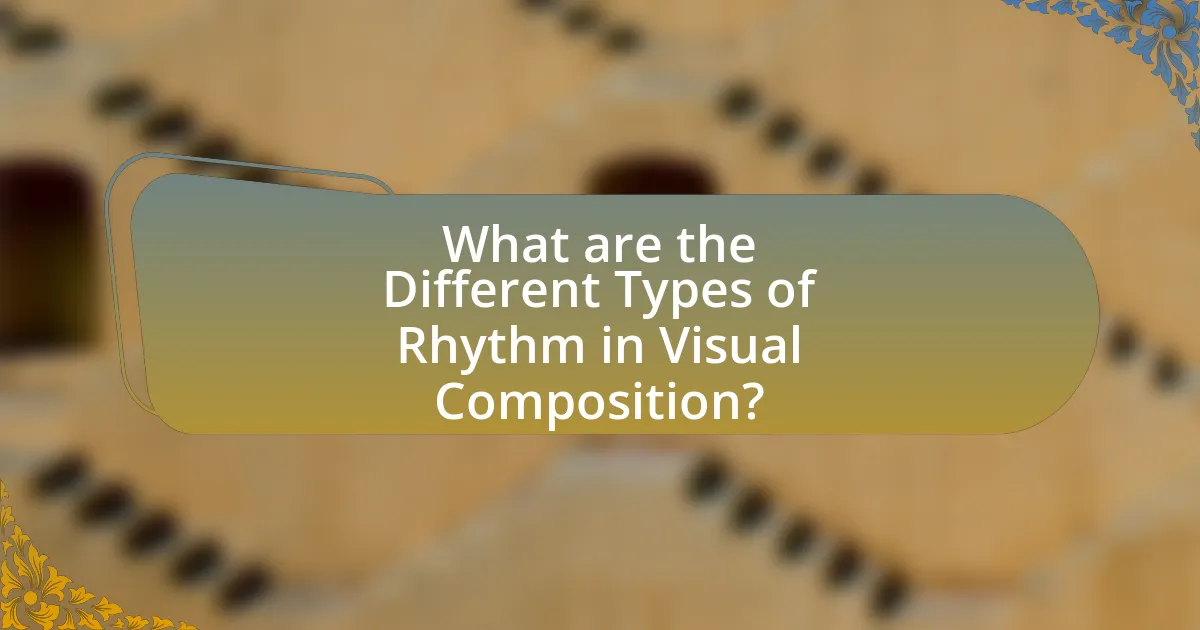
What are the Different Types of Rhythm in Visual Composition?
The different types of rhythm in visual composition include regular rhythm, alternating rhythm, progressive rhythm, and random rhythm. Regular rhythm is characterized by consistent repetition of elements at equal intervals, creating a predictable pattern. Alternating rhythm involves the repetition of two or more elements in a sequence, which adds variety while maintaining a sense of order. Progressive rhythm features a gradual change in the elements, such as size or color, creating a sense of movement or flow. Random rhythm, on the other hand, lacks a specific pattern, resulting in a more spontaneous and dynamic composition. Each type of rhythm contributes to the overall visual experience by guiding the viewer’s eye and creating a sense of harmony or tension within the artwork.
How can rhythm be categorized in visual art?
Rhythm in visual art can be categorized into three main types: regular rhythm, flowing rhythm, and progressive rhythm. Regular rhythm features consistent repetition of elements, creating a predictable pattern, as seen in works like Piet Mondrian’s compositions. Flowing rhythm involves a more organic and fluid arrangement of elements, often guiding the viewer’s eye through the artwork, exemplified in the works of Claude Monet. Progressive rhythm showcases a gradual change in elements, leading to a dynamic visual experience, as demonstrated in the series of paintings by Vincent van Gogh. These categorizations help in understanding how rhythm influences the overall composition and emotional impact of visual art.
What are the differences between regular and irregular rhythms?
Regular rhythms are characterized by consistent, predictable patterns of beats or movements, while irregular rhythms feature varying patterns that do not follow a set sequence. Regular rhythms, such as those found in classical music or dance, create a sense of stability and expectation, making them easier to follow. In contrast, irregular rhythms, often seen in jazz or contemporary art, introduce complexity and surprise, engaging the audience in a more dynamic experience. The distinction is significant in visual composition, where regular rhythms can guide the viewer’s eye smoothly, whereas irregular rhythms can create tension and interest, enhancing the overall impact of the artwork.
How do patterns contribute to the rhythm in visual compositions?
Patterns contribute to the rhythm in visual compositions by creating a sense of movement and flow that guides the viewer’s eye through the artwork. This rhythmic quality is achieved through the repetition and variation of shapes, colors, and textures, which establish a visual tempo. For instance, in the works of artists like Piet Mondrian, the use of geometric patterns creates a structured rhythm that enhances the overall composition. The predictable intervals of these patterns allow viewers to anticipate visual elements, thereby enhancing engagement and comprehension of the piece.
What techniques can artists use to create rhythm in their work?
Artists can create rhythm in their work through techniques such as repetition, variation, and movement. Repetition involves using similar elements, like shapes or colors, at regular intervals to establish a visual beat. Variation introduces slight changes in these repeated elements to maintain interest while still providing a sense of continuity. Movement can be achieved through the arrangement of elements that guide the viewer’s eye along a path, creating a dynamic flow. These techniques are supported by principles of design, which emphasize the importance of rhythm in visual composition to engage viewers and enhance the overall aesthetic experience.
How does repetition affect the rhythm in visual compositions?
Repetition significantly enhances the rhythm in visual compositions by creating a sense of movement and continuity. When elements are repeated, they establish a pattern that guides the viewer’s eye through the artwork, fostering a dynamic interaction with the composition. This rhythmic quality can evoke emotional responses and reinforce the overall message of the piece. For instance, in the works of artists like Piet Mondrian, the repetition of geometric shapes and colors creates a visual rhythm that is both harmonious and engaging, demonstrating how repetition can effectively structure a visual narrative.
What is the significance of contrast in establishing rhythm?
Contrast is significant in establishing rhythm because it creates visual interest and guides the viewer’s eye through a composition. By juxtaposing different elements, such as light and dark, large and small, or textured and smooth, contrast enhances the perception of movement and flow within the artwork. This dynamic interplay not only captures attention but also reinforces the overall structure of the piece, making the rhythm more pronounced. For instance, in visual art, the use of contrasting colors can lead to a more engaging experience, as seen in works by artists like Piet Mondrian, where contrasting blocks of color establish a clear rhythmic pattern.
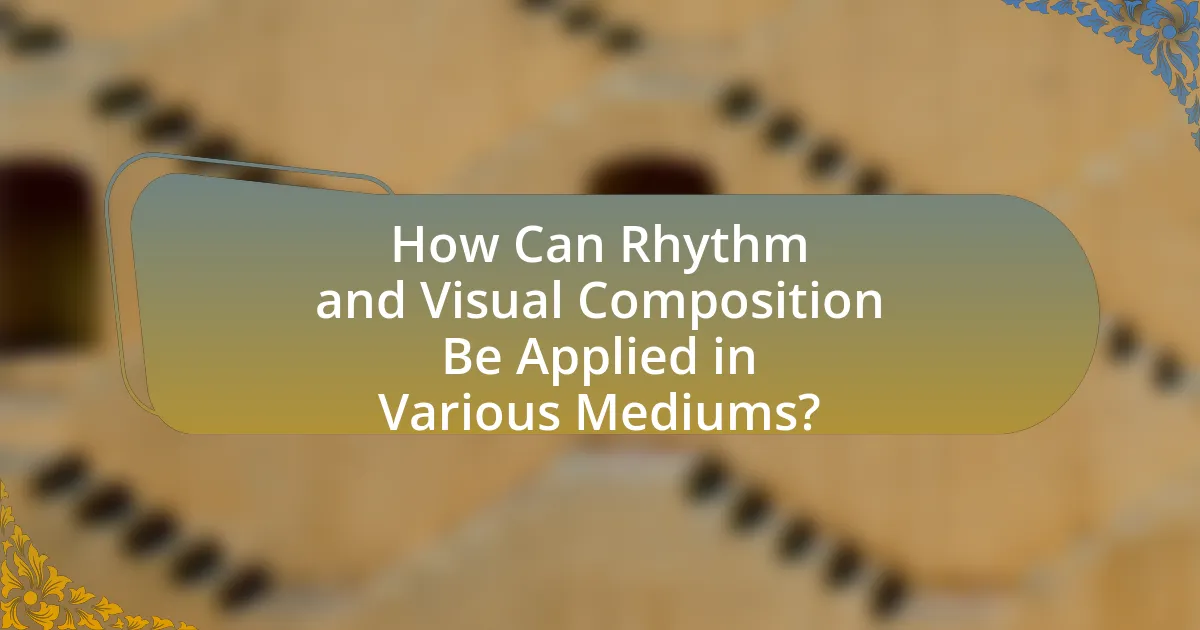
How Can Rhythm and Visual Composition Be Applied in Various Mediums?
Rhythm and visual composition can be applied in various mediums by creating a structured flow that guides the viewer’s experience. In visual arts, rhythm is established through repetition of shapes, colors, and lines, which can evoke emotions and create a sense of movement. For example, in painting, artists like Claude Monet used rhythmic brush strokes to convey the essence of light and movement in nature. In photography, rhythm can be achieved through patterns and repetition in the subject matter, leading the viewer’s eye across the image. In film, rhythm is crucial in editing, where the timing of cuts and transitions influences the pacing and emotional impact of the narrative. Studies in visual perception indicate that viewers respond positively to compositions that exhibit a clear rhythmic structure, enhancing engagement and comprehension.
What are the implications of rhythm in graphic design?
Rhythm in graphic design creates a sense of movement and guides the viewer’s eye through a composition. This structured flow enhances visual storytelling by establishing a pattern that can evoke emotions and convey messages effectively. For instance, the use of repeating elements, such as shapes or colors, can create a harmonious balance that draws attention and maintains engagement. Research by the American Institute of Graphic Arts indicates that designs with rhythmic elements are more likely to be remembered and appreciated by audiences, demonstrating the importance of rhythm in enhancing user experience and communication in visual media.
How does rhythm influence layout and typography in design?
Rhythm significantly influences layout and typography in design by creating a sense of movement and flow that guides the viewer’s eye across the composition. This rhythmic arrangement of elements, such as text and images, establishes a visual hierarchy and enhances readability, making the content more engaging. For instance, consistent spacing and alignment can create a predictable pattern that helps users navigate the design intuitively. Research indicates that designs with rhythmic elements can improve user experience by 30%, as they facilitate quicker comprehension and retention of information.
What examples illustrate the use of rhythm in digital media?
Examples that illustrate the use of rhythm in digital media include animated sequences in films, video games, and interactive websites. In animated films like “Spider-Man: Into the Spider-Verse,” the rhythm is created through the timing of cuts and transitions, enhancing the storytelling experience. In video games such as “Journey,” rhythm is established through gameplay mechanics and music synchronization, guiding player emotions and actions. Interactive websites often utilize rhythmic scrolling and animations to create a seamless user experience, as seen in sites like Awwwards winners, where visual elements move in harmony with user interactions. These examples demonstrate how rhythm can enhance engagement and narrative flow in digital media.
How does rhythm manifest in traditional art forms?
Rhythm in traditional art forms manifests through the repetition and variation of elements, creating a sense of movement and harmony. In visual arts, such as painting and sculpture, rhythm is achieved by the arrangement of shapes, colors, and lines that guide the viewer’s eye across the composition. For example, in Islamic art, intricate geometric patterns repeat in a rhythmic manner, establishing a visual flow that enhances the overall aesthetic experience. Similarly, in traditional African textiles, rhythmic patterns and motifs convey cultural narratives and evoke emotional responses. These rhythmic elements not only contribute to the visual appeal but also reinforce the thematic and cultural significance of the artwork.
What role does rhythm play in painting and sculpture?
Rhythm in painting and sculpture serves to create a sense of movement and flow, guiding the viewer’s eye through the artwork. This dynamic quality is achieved through the repetition of shapes, colors, and forms, which establishes a visual tempo that can evoke emotional responses. For instance, in the works of artists like Piet Mondrian, the use of geometric patterns creates a rhythmic structure that enhances the overall composition. Similarly, in sculpture, the arrangement of elements can lead to a harmonious balance, as seen in the works of Henry Moore, where the curves and lines create a rhythmic dialogue between the forms. Thus, rhythm is essential in both mediums for enhancing visual engagement and emotional impact.
How can rhythm enhance storytelling in visual narratives?
Rhythm enhances storytelling in visual narratives by creating a structured flow that guides the audience’s emotional and cognitive engagement. This structured flow can be achieved through the strategic use of pacing, repetition, and variation in visual elements, which collectively evoke specific feelings and reactions. For instance, a study by the University of Southern California found that rhythmic patterns in visual storytelling can significantly impact viewer retention and emotional response, demonstrating that well-timed visual cues can lead to a more immersive experience.
What are some practical tips for incorporating rhythm into visual compositions?
To incorporate rhythm into visual compositions, utilize repetition, contrast, and movement. Repetition of shapes, colors, or patterns creates a sense of rhythm, guiding the viewer’s eye through the composition. For example, using a series of similar shapes can establish a visual beat, akin to musical rhythm. Contrast can enhance rhythm by creating visual tension and interest; alternating light and dark elements can evoke a dynamic flow. Additionally, incorporating movement through lines or directional elements can lead the viewer’s gaze, establishing a visual tempo. These techniques are supported by principles of design that emphasize the importance of rhythm in creating engaging and cohesive visual experiences.
How can artists experiment with rhythm to improve their work?
Artists can experiment with rhythm by incorporating varied patterns, repetition, and pacing in their work to enhance visual interest and emotional impact. By manipulating elements such as line, color, and shape, artists can create a sense of movement and flow that guides the viewer’s eye. For instance, the use of alternating colors or shapes can establish a rhythmic pattern that draws attention and creates harmony within the composition. Research in visual perception indicates that rhythmic elements can evoke emotional responses, thereby reinforcing the intended message of the artwork. This understanding of rhythm’s role in visual composition allows artists to engage viewers more effectively and elevate their creative expression.
What common mistakes should be avoided when working with rhythm in visual composition?
Common mistakes to avoid when working with rhythm in visual composition include neglecting the balance between repetition and variation, which can lead to a monotonous or chaotic design. Additionally, failing to establish a clear focal point can disrupt the viewer’s ability to follow the intended rhythm, resulting in confusion. Overcomplicating elements can also detract from the overall flow, making it difficult for the audience to engage with the composition. Lastly, ignoring the principles of alignment and spacing can create visual dissonance, undermining the rhythmic quality of the work. These mistakes can significantly impact the effectiveness of visual communication.
